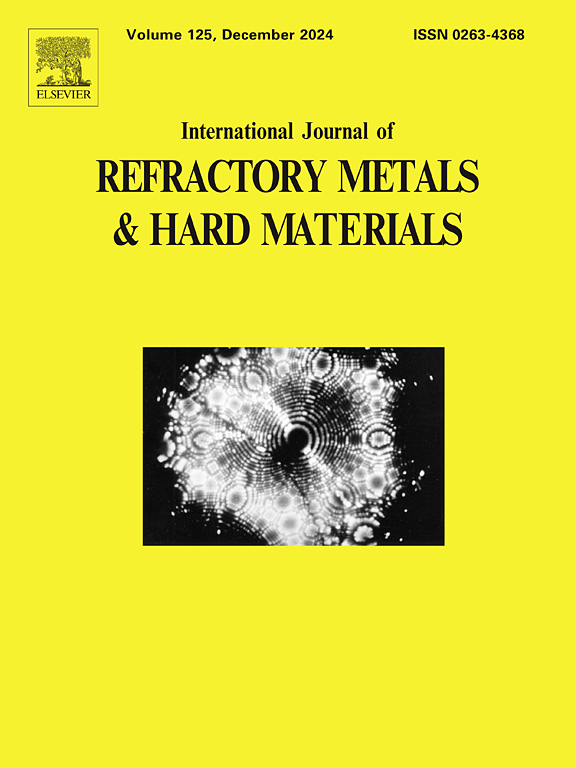Accelerated molten salt electro-deoxidation for ultrafine tantalum powder synthesis via intermediate microstructural modulation
IF 4.2
2区 材料科学
Q2 MATERIALS SCIENCE, MULTIDISCIPLINARY
International Journal of Refractory Metals & Hard Materials
Pub Date : 2025-07-16
DOI:10.1016/j.ijrmhm.2025.107333
引用次数: 0
Abstract
The molten salt electro-deoxidation, i.e. the FFC (Fray-Farthing-Chen) process, demonstrates considerable potential for the synthesis of tantalum powder. However, its practical application is hindered by the long electrolysis duration. This study proposes an accelerated electro-deoxidation process in molten Na3AlF6-AlF3 salts for preparing ultrafine Ta powder, which achieves a sequential cathode phase transformation from Ta2O5 through intermediate NaTaO3 to Ta. NaTaO3 is formed through in situ interfacial reactions between Ta2O5 and the electrolyte. We demonstrate for the first time that the growth of the FFC-type intermediate is driven by nanoparticle assembly and oriented attachment mechanism. This growth mechanism is influenced by the structure of the electrolyte/particle interface. By constructing a novel hierarchical pore structure Ta2O5 cathode with optimized interfaces, we facilitated a microstructurally controllable transformation of Ta2O5 to fine NaTaO3, thereby effectively mitigating the elongation of oxygen ions solid diffusion pathway induced by intermediate coarsening. In the case of self-assembled NaTaO3, the weak bonding between the nanoparticles also favors the kinetics of their subsequent decomposition into Ta. This approach has been shown to enable the complete reduction of 1 g of Ta2O5 within only 1 h, demonstrating a significant enhancement in process efficiency. The resulting Ta powder exhibits uniform monodisperse morphology and good capacitive behavior in Na2SO4 electrolyte solution. The present study may now guide the way towards establishing the electrochemical route for the efficient preparation of many other refractory powders materials.

中间微结构调制加速熔盐电脱氧合成超细钽粉
熔盐电脱氧,即FFC (fra - farthing - chen)工艺,在合成钽粉方面显示出相当大的潜力。但电解时间长,阻碍了其实际应用。本研究提出了在熔融Na3AlF6-AlF3盐中加速电脱氧制备超细Ta粉的工艺,实现了从Ta2O5到中间的NaTaO3到Ta的顺序阴极相变。naao3是通过Ta2O5与电解质之间的原位界面反应形成的。我们首次证明了ffc型中间体的生长是由纳米颗粒组装和定向附着机制驱动的。这种生长机制受电解质/颗粒界面结构的影响。通过构建具有优化界面的新型分层孔结构Ta2O5阴极,促进了Ta2O5向精细NaTaO3的微观结构可控转变,从而有效缓解了中间粗化引起的氧离子固体扩散途径的延伸。在自组装NaTaO3的情况下,纳米颗粒之间的弱键也有利于它们随后分解成Ta的动力学。这种方法已被证明可以在1小时内完全还原1g Ta2O5,这表明了工艺效率的显着提高。制备的Ta粉在Na2SO4电解质溶液中具有均匀的单分散形貌和良好的电容性能。本研究可为建立电化学路线,有效制备其他耐火粉末材料提供指导。
本文章由计算机程序翻译,如有差异,请以英文原文为准。
求助全文
约1分钟内获得全文
求助全文
来源期刊
CiteScore
7.00
自引率
13.90%
发文量
236
审稿时长
35 days
期刊介绍:
The International Journal of Refractory Metals and Hard Materials (IJRMHM) publishes original research articles concerned with all aspects of refractory metals and hard materials. Refractory metals are defined as metals with melting points higher than 1800 °C. These are tungsten, molybdenum, chromium, tantalum, niobium, hafnium, and rhenium, as well as many compounds and alloys based thereupon. Hard materials that are included in the scope of this journal are defined as materials with hardness values higher than 1000 kg/mm2, primarily intended for applications as manufacturing tools or wear resistant components in mechanical systems. Thus they encompass carbides, nitrides and borides of metals, and related compounds. A special focus of this journal is put on the family of hardmetals, which is also known as cemented tungsten carbide, and cermets which are based on titanium carbide and carbonitrides with or without a metal binder. Ceramics and superhard materials including diamond and cubic boron nitride may also be accepted provided the subject material is presented as hard materials as defined above.

 求助内容:
求助内容: 应助结果提醒方式:
应助结果提醒方式:


